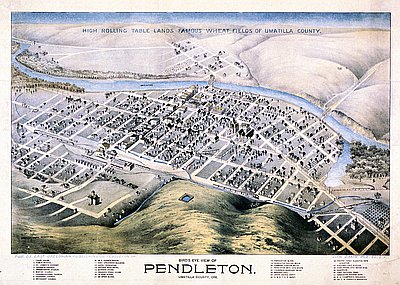Northeastern Oregon gained little in the way of war jobs. Most of the major military bases were on the other side of the Cascades, and defense plants were in and around Portland. Hermiston became home to the Army Ordnance Depot, the first of several federal projects that would boost its population and economy. Pendleton had a training base.
But the war nevertheless quickened the entire area’s economy. Farmers and ranchers sold their crops for good money for the first time in decades, and the timber industry also rebounded.
The population of northeastern Oregon continued to stagnate or decline during the 1930s and World War II. Sherman, Gilliam, and Wallowa Counties were the only ones in Oregon to suffer a net population loss during both the 1930s and the 1940s. Many white laborers left for high-paying defense jobs in Portland, the Tri-Cities of eastern Washington, or farther afield, and farm mechanization continued to make farming more efficient. Many young men and some women left to serve their country overseas and did not return.
Ontario and its environs continued the impressive expansion that the irrigation projects had fuelled in the 1930s. A survey of the Vale area found that its residents had organized two granges, a pair of women’s clubs, a Home Economics Club, and several other associations during the Depression.
Latinos had lived and traveled through eastern Oregon since the 1850s, often as miners, cowhands, or packers. Growing numbers labored on Nyssa-area farms after World War I. The Depression prompted Anglo officials to drive Mexican workers out of the U.S., but the labor shortages of World War II reversed this policy. The Ontario Chamber of Commerce ordered stores to display signs reading: “Closed until 1 P.M. Daily except Saturday, Everyone Thinning Beets.” Japanese American workers eager to prove their loyalty and escape the confines of concentration camps took up some of the slack. When labor remained scarce, large growers turned to the Bracero program, a federally-brokered arrangement that brought workers from Mexico to U.S. farms. Wages and working conditions were low, and participants had few legal rights and were expected to return to Mexico. But more and more Mexican immigrants would make themselves at home in and around Ontario and other parts of northeastern Oregon during and after World War II, even as many others came and went.
© David Peterson del Mar, 2005. Updated and revised by OHP staff, 2014.









